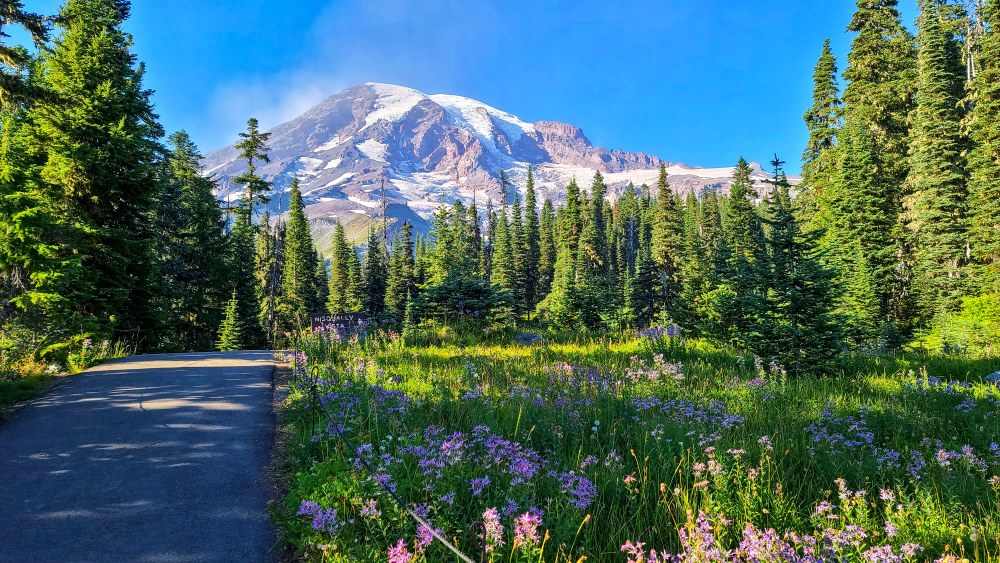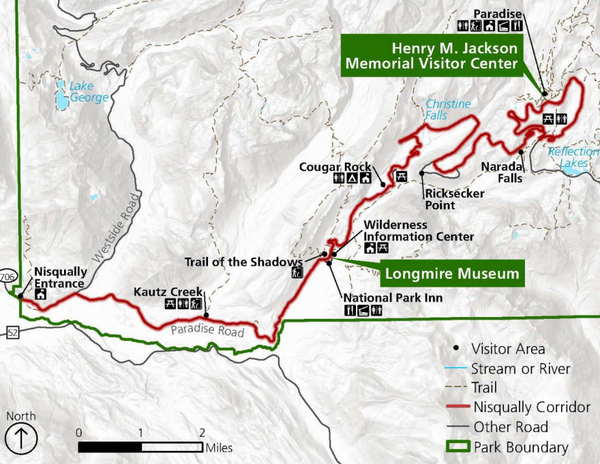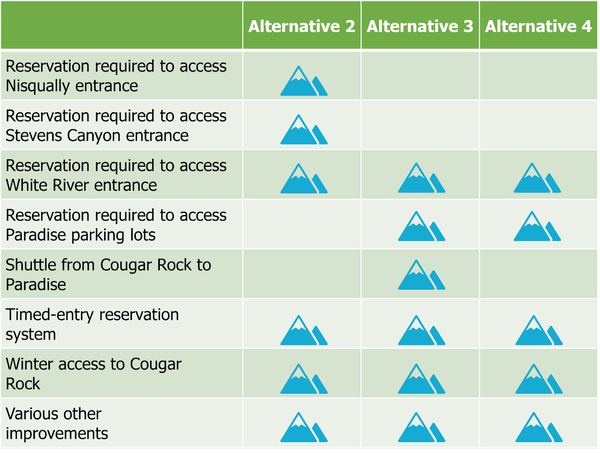
Note: The comment period for the draft visitor use management plan is now closed. Learn more about The Mountaineers concerns with the plan in this blog. We'll continue to update our community as this process develops. Thank you for your interest and engagement in this important issue.
In response to increased visitation during the peak summer season, Mount Rainier National Park recently proposed significant changes to how people access the park. The Nisqually to Paradise Corridor Draft Management Plan proposes to implement a timed-entry reservation system for popular areas of the park. This proposal could dramatically change how Mountaineers programs and members access places like Paradise and Sunrise.
Mount Rainier National Park has been developing this plan for the last three years and have previously sought public feedback on how to address congestion and protect natural resources. The Mountaineers submitted comment letters in 2020 and 2021 and shared updates on this process with our community. Now that the park has shared specific proposals, it’s important to learn more about the draft plan and share your feedback.
Key Issues and Goals
Like many national parks and public lands, Mount Rainier grows in popularity each year. From 2008 to 2021, annual visitation rose from 1.1 million visits per year to more than 1.7 million visits. The management plan seeks to address a number of current issues, including roadway and parking lot congestion, facility overuse on busy summer days, protecting alpine meadows and other natural resources, and enhancing the quality of the visitor experience.
The stated goal of the plan is to provide high quality visitor experiences while protecting park resources and values. The Park believes that limiting the number of people who can visit popular areas each day will provide for a better visitor experience and increased protection for natural and cultural resources.

Map of the Nisqually to Paradise Corridor. Courtesy of the National Park Service.
Proposed Strategies
The draft plan includes three action alternatives (options) that would proactively manage and pace the entry of vehicles into key areas of the park like Paradise and Sunrise. All three alternatives include some variation of a timed-entry reservation season from approximately July 1 to Labor Day. These proposals intend to target the times of the year and locations that experience the most visitation.
The draft plan proposes four alternatives, including a no-action alternative:
Alternative 1: No-Action Alternative
- Current management would continue, with visitors continuing to spontaneously access destinations in the park.
Alternative 2: Corridor-Level Access Management (NPS Preferred Alternative)
- The Park would establish a reservation system for the Nisqually, Stevens Canyon, and White River entrances. Access to all destinations beyond those entrances would require a reservation.
Alternative 3: Site-Level Access Management with Cougar Rock to Paradise Shuttle
- The Park would establish a reservation system for visitors to access Paradise and provide a within-park shuttle system from Cougar Rock picnic area to Paradise. Visitors without a Paradise parking reservation could have the option of parking at Cougar Rock and taking the shuttle. The shuttle would be initially first come, first serve, but it could require a reservation if demand exceeds supply.
- A reservation system would be implemented at the White River entrance.
Alternative 4: Site-Level Access Management
- The Park would establish a reservation system for visitors to access Paradise parking lots and the White River entrance.
Common to Alternatives 2-4:
- During initial implementation, the timed-entry system would be active during the peak season (July 1-Labor Day) from 7am-5pm. A percentage of reservations would be available for long-term purchase as well as short term-purchase. Visitors with a reservation (e.g. wilderness or climbing permit, lodge, campground, or inn reservations) would not need a separate park entrance reservation.
- Winter day use access would be expanded at Cougar Rock by opening the road from Longmire to Cougar Rock during some days when it is not possible to open the road to Paradise.
- Various improvements to signage and wayfinding, scenic vistas, accessibility, trails, trailheads, picnic areas, parking areas.
Table showing the similarities between the proposed management alternatives.
We are working to learn more about the effects of this proposal on Mountaineers programs and to analyze its impacts on outdoor recreation and natural resources. We plan to submit a comment letter detailing our organization's perspectives on the draft plan and proposed alternatives. Please reach out to our conservation team to share your input.
We strongly encourage Mountaineers to review the draft plan and share your feedback. You can submit your comments directly to the park through June 26. Like all public lands, Mount Rainier National Park is your park, so please speak up!
The Park will review all submitted comments this summer and make a final decision later this year. Any changes would begin to be implemented in 2024.
For more on The Mountaineers concerns with the draft visitor use management plan, check out this blog .
Add a comment
Log in to add comments."Visitors with a reservation (e.g. wilderness or climbing permit, lodge or inn reservations) would not need a separate park entrance reservation."
What about visitors with a campground reservation?
Hi Yann. Visitors with a campground reservation would not need a separate park entrance reservation. We've updated the blog content accordingly. Thank you!
There was a time when The Mountaineers used private bus transportation for Alpine Scrambling and Basic Climbing Course group outings/overnights to MORA. Can we look at doing that again? 1 group reservation and 1 vehicle for 40+ people would place a lot less stress on the park and the reservation system, whichever is selected.
Thanks for the suggestion, Jeff. How we run courses is ultimately up to committees. If the park does implement timed reservations, committees could consider this option.
The link to the proposal and comment form states the comment period closes June 11th, not 26th.
I tried to read the proposal as it was written. I was impressed by how untargeted the subject matter was. Trying to find the exact language for the proposed changes was seemingly impossible. Add to that the document is 220 pages long!
Given that what is in this webpost is slightly different from what my reading was in the Seattle Times, and from someone who attended the live meeting, I'm thinking I'm going to have to bite the bullet, print it out and spend Memeorial Day weekend reading while we camp.
Hi Michelle, Thanks for sharing your thoughts and engaging on this important issue. The Park has officially extended the deadline for comments to June 26, 2023.
I went to Glacier National Park last year and I'm assuming it was Alternative #2 that they used. You were required to have a reservation (available online) for entrance (between 8am -4pm?). You were able to walk in but I'm not sure what good that is unless you could hitch a ride with someone. I think that it is good to keep it as simple as possible. Adding various different options (pass for this, or pass for that) just leads to more confusion. I understand and welcome the need to reduce congestion in the park. At the same time there are many areas where even on a busy day a person can go and be in relative isolation. If the restriction is for cars only, I'm wondering if e-bikes can access the park with no reservation. I also can see a shuttle bus running the crowds to Paradise & Sunrise which are the busy areas and allow people to access some of the lesser traveled parts of the park. It is tricky to come up with a solution to keep everyone happy. Having an America the Beautiful pass is no longer enough and planning ahead is much more critical.
 The Mountaineers
The Mountaineers
